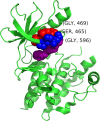A spatial simulation approach to account for protein structure when identifying non-random somatic mutations
- PMID: 24990767
- PMCID: PMC4227039
- DOI: 10.1186/1471-2105-15-231
A spatial simulation approach to account for protein structure when identifying non-random somatic mutations
Abstract
Background: Current research suggests that a small set of "driver" mutations are responsible for tumorigenesis while a larger body of "passenger" mutations occur in the tumor but do not progress the disease. Due to recent pharmacological successes in treating cancers caused by driver mutations, a variety of methodologies that attempt to identify such mutations have been developed. Based on the hypothesis that driver mutations tend to cluster in key regions of the protein, the development of cluster identification algorithms has become critical.
Results: We have developed a novel methodology, SpacePAC (Spatial Protein Amino acid Clustering), that identifies mutational clustering by considering the protein tertiary structure directly in 3D space. By combining the mutational data in the Catalogue of Somatic Mutations in Cancer (COSMIC) and the spatial information in the Protein Data Bank (PDB), SpacePAC is able to identify novel mutation clusters in many proteins such as FGFR3 and CHRM2. In addition, SpacePAC is better able to localize the most significant mutational hotspots as demonstrated in the cases of BRAF and ALK. The R package is available on Bioconductor at: http://www.bioconductor.org/packages/release/bioc/html/SpacePAC.html.
Conclusion: SpacePAC adds a valuable tool to the identification of mutational clusters while considering protein tertiary structure.
Figures








Similar articles
-
Leveraging protein quaternary structure to identify oncogenic driver mutations.BMC Bioinformatics. 2016 Mar 22;17:137. doi: 10.1186/s12859-016-0963-3. BMC Bioinformatics. 2016. PMID: 27001666 Free PMC article.
-
A graph theoretic approach to utilizing protein structure to identify non-random somatic mutations.BMC Bioinformatics. 2014 Mar 26;15:86. doi: 10.1186/1471-2105-15-86. BMC Bioinformatics. 2014. PMID: 24669769 Free PMC article.
-
Utilizing protein structure to identify non-random somatic mutations.BMC Bioinformatics. 2013 Jun 13;14:190. doi: 10.1186/1471-2105-14-190. BMC Bioinformatics. 2013. PMID: 23758891 Free PMC article.
-
Identifying Epistasis in Cancer Genomes: A Delicate Affair.Cell. 2019 May 30;177(6):1375-1383. doi: 10.1016/j.cell.2019.05.005. Cell. 2019. PMID: 31150618 Free PMC article. Review.
-
Identifying driver mutations from sequencing data of heterogeneous tumors in the era of personalized genome sequencing.Brief Bioinform. 2014 Mar;15(2):244-55. doi: 10.1093/bib/bbt042. Epub 2013 Jul 1. Brief Bioinform. 2014. PMID: 23818492 Review.
Cited by
-
Computational Approaches to Prioritize Cancer Driver Missense Mutations.Int J Mol Sci. 2018 Jul 20;19(7):2113. doi: 10.3390/ijms19072113. Int J Mol Sci. 2018. PMID: 30037003 Free PMC article. Review.
-
Functional characterization of 3D protein structures informed by human genetic diversity.Proc Natl Acad Sci U S A. 2019 Apr 30;116(18):8960-8965. doi: 10.1073/pnas.1820813116. Epub 2019 Apr 15. Proc Natl Acad Sci U S A. 2019. PMID: 30988206 Free PMC article.
-
3D clusters of somatic mutations in cancer reveal numerous rare mutations as functional targets.Genome Med. 2017 Jan 23;9(1):4. doi: 10.1186/s13073-016-0393-x. Genome Med. 2017. PMID: 28115009 Free PMC article.
-
Leveraging protein dynamics to identify cancer mutational hotspots using 3D structures.Proc Natl Acad Sci U S A. 2019 Sep 17;116(38):18962-18970. doi: 10.1073/pnas.1901156116. Epub 2019 Aug 28. Proc Natl Acad Sci U S A. 2019. PMID: 31462496 Free PMC article.
-
Functional consequences of somatic mutations in cancer using protein pocket-based prioritization approach.Genome Med. 2014 Oct 14;6(10):81. doi: 10.1186/s13073-014-0081-7. eCollection 2014. Genome Med. 2014. PMID: 25360158 Free PMC article.
References
-
- Vogelstein B, Kinzler KW. Cancer genes and the pathways they control. Nat Med. 2004;10(8):789–799. [ http://www.ncbi.nlm.nih.gov/pubmed/15286780]. [PMID: 15286780] - PubMed
-
- Faivre S, Kroemer G, Raymond E. Current development of mTOR, inhibitors as anticancer agents. Nat Rev Drug Discov. 2006;5(8):671–688. [ http://www.nature.com/doifinder/10.1038/nrd2062] - DOI - PubMed
-
- Hartmann JT, Haap M, Kopp HG, Lipp HP. Tyrosine kinase inhibitors - a review on pharmacology, metabolism and side effects. Curr Drug Metab. 2009;10(5):470–481. [PMID:, 1968 9244] - PubMed
-
- Moreau P, Richardson PG, Cavo M, Orlowski RZ, San Miguel JF, Palumbo A, Harousseau JL. Proteasome inhibitors in multiple myeloma: 10 years later. Blood. 2012;120(5):947–959. [ http://www.bloodjournal.org/cgi/doi/10.1182/blood-2012-04-403733] - DOI - PMC - PubMed
-
- Greenman C, Stephens P, Smith R, Dalgliesh GL, Hunter C, Bignell G, Davies H, Teague J, Butler A, Stevens C, Edkins S, Vastrik I, Schmidt EE, Avis T, Barthorpe S, Bhamra G, Buck G, Choudhury B, Clements J, Cole J, Dicks E, Forbes S, Gray K, Halliday K, Harrison R, Hills K, Hinton J, Jenkinson A, Jones D, Menzies A, Mironenko T. O’Meara S et al.Patterns of somatic mutation in human cancer genomes. Nature. 2007;446(7132):153–158. [ http://www.nature.com/doifinder/10.1038/nature05610] - DOI - PMC - PubMed
Publication types
MeSH terms
Substances
Grants and funding
LinkOut - more resources
Full Text Sources
Other Literature Sources
Molecular Biology Databases
Research Materials

